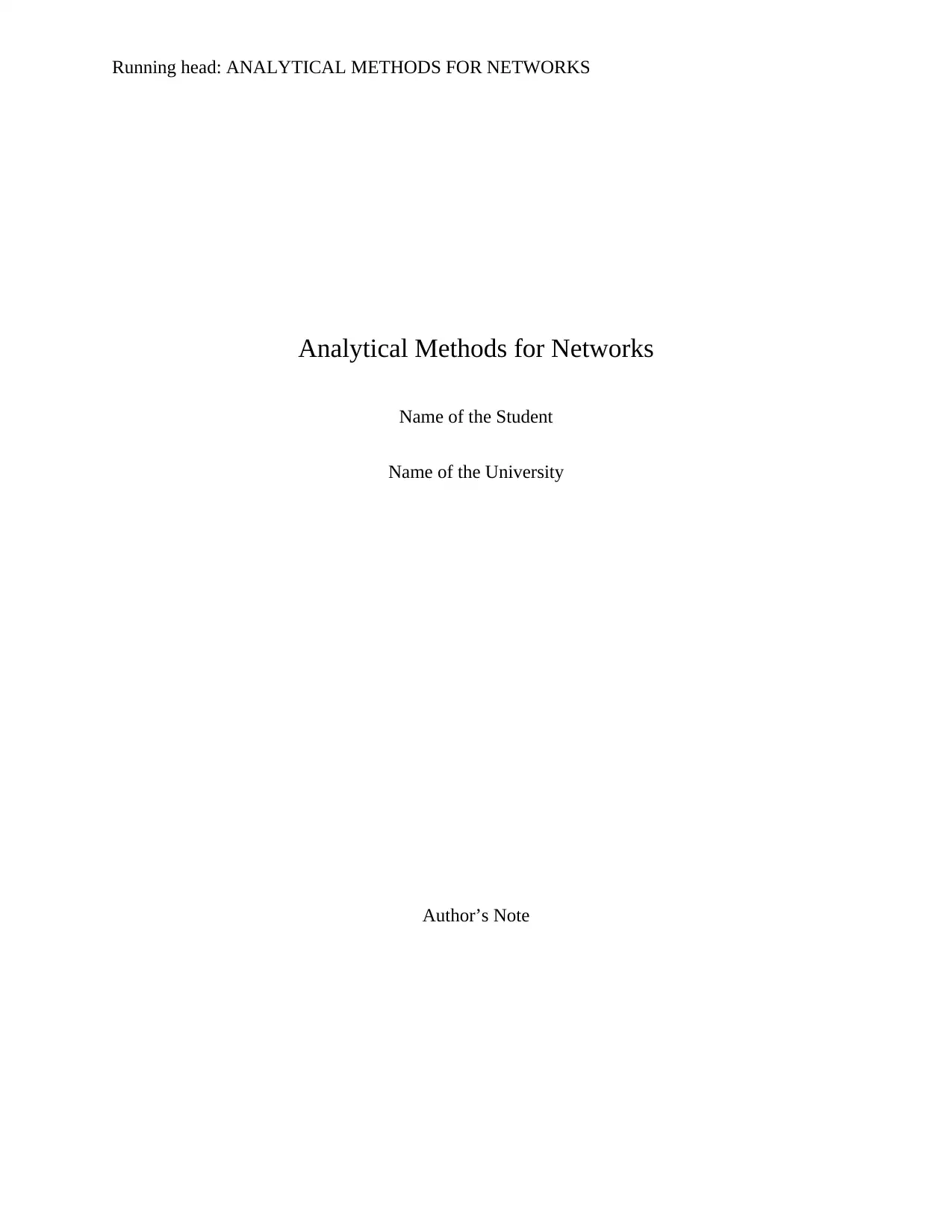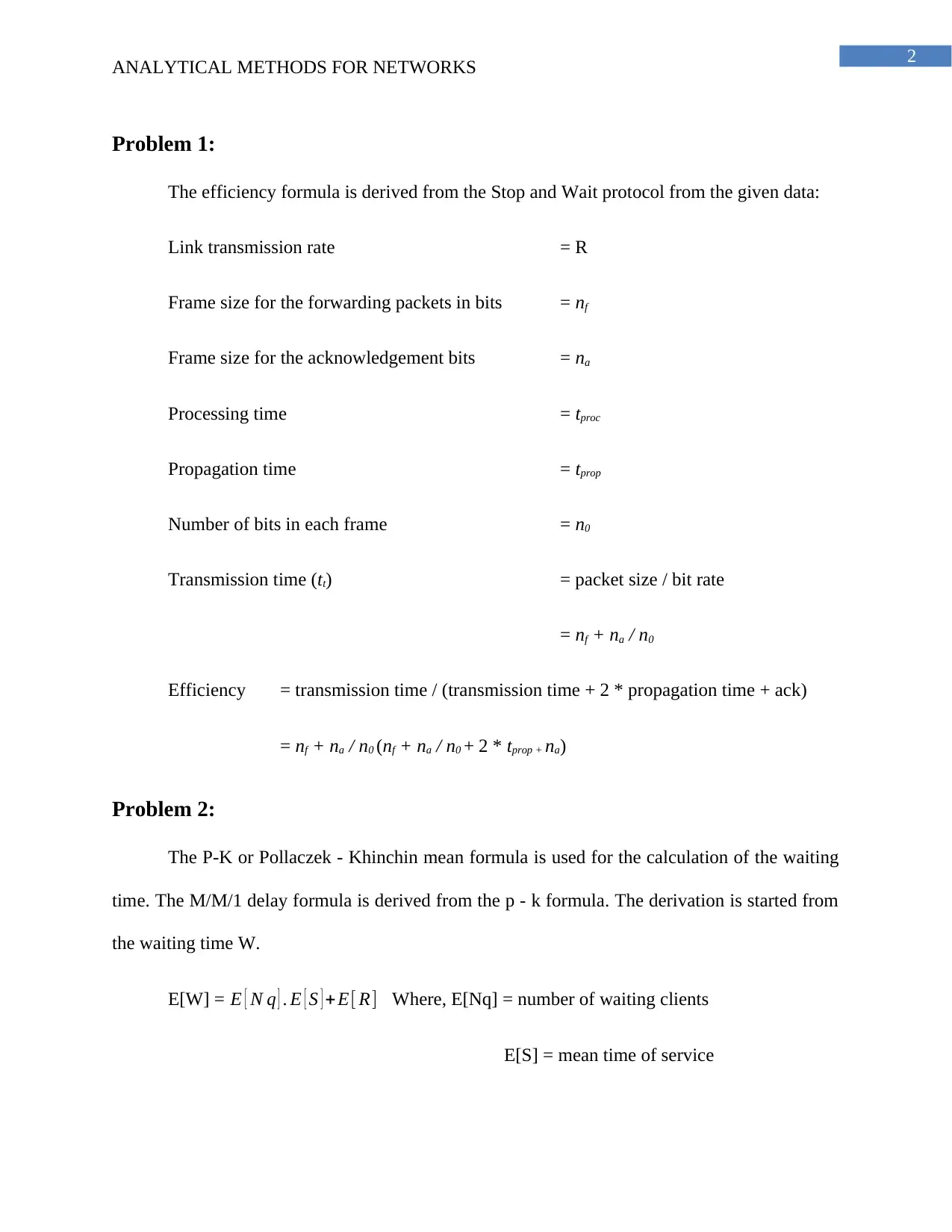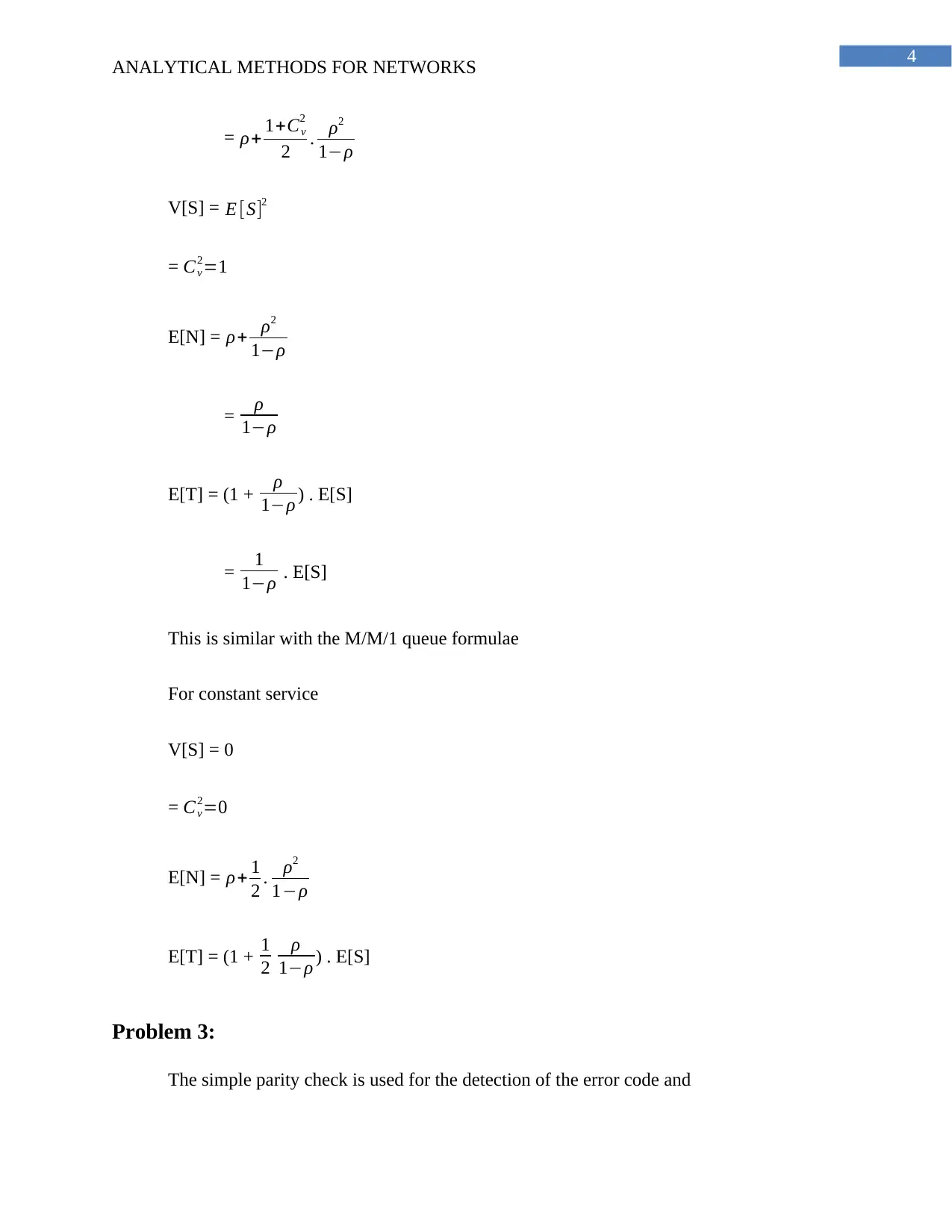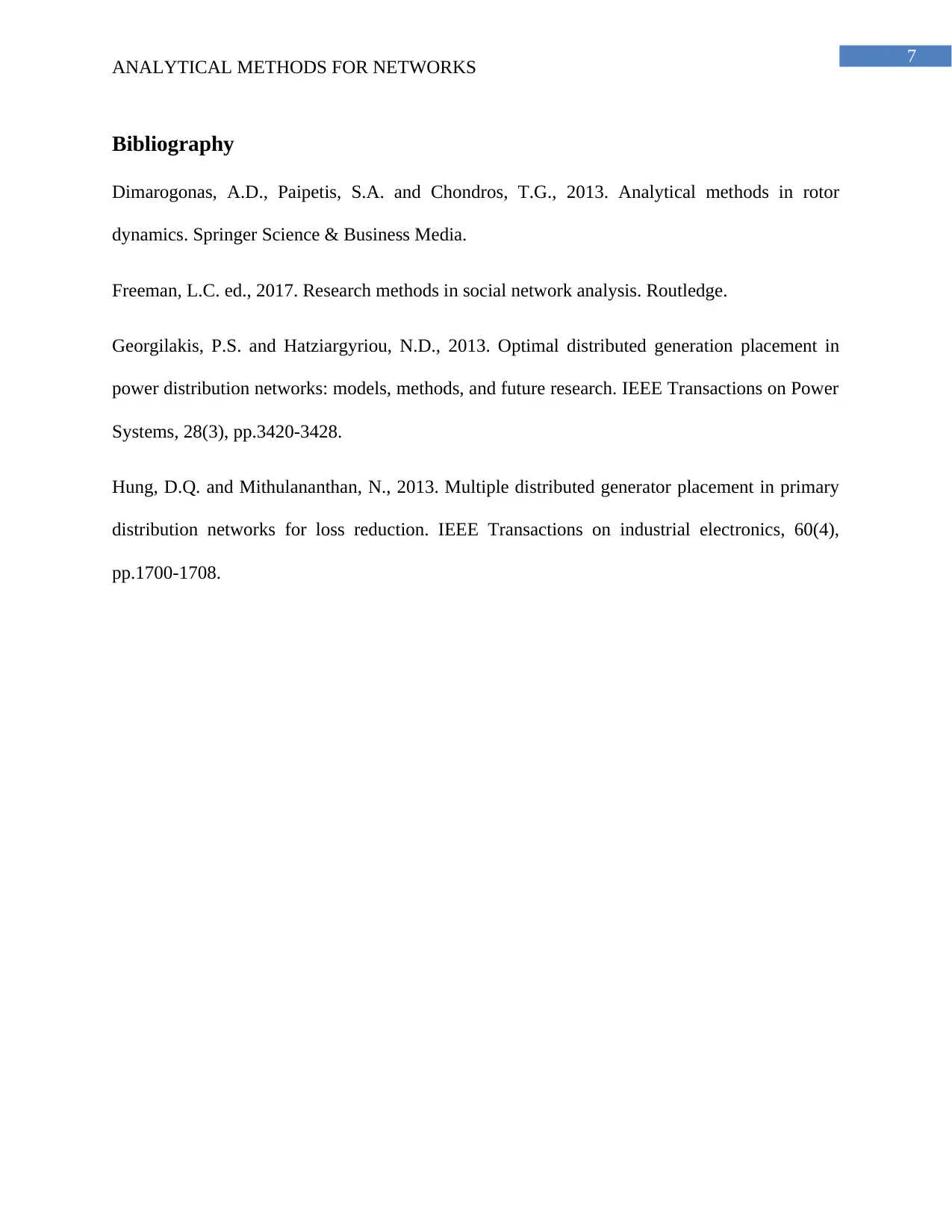Electrical Engineering: Analytical Methods for Networks Assignment
VerifiedAdded on 2020/05/04
|8
|844
|186
Homework Assignment
AI Summary
This document presents a comprehensive solution to an analytical methods for networks assignment, suitable for electrical engineering students. It begins with the derivation of the efficiency formula from the Stop and Wait protocol, detailing the impact of link transmission rates, frame sizes, and pro...

Running head: ANALYTICAL METHODS FOR NETWORKS
Analytical Methods for Networks
Name of the Student
Name of the University
Author’s Note
Analytical Methods for Networks
Name of the Student
Name of the University
Author’s Note
Paraphrase This Document
Need a fresh take? Get an instant paraphrase of this document with our AI Paraphraser

1
ANALYTICAL METHODS FOR NETWORKS
Table of Contents
Problem 1:............................................................................................................................2
Problem 2:............................................................................................................................2
Problem 3:............................................................................................................................4
Problem 4:............................................................................................................................5
Bibliography........................................................................................................................7
ANALYTICAL METHODS FOR NETWORKS
Table of Contents
Problem 1:............................................................................................................................2
Problem 2:............................................................................................................................2
Problem 3:............................................................................................................................4
Problem 4:............................................................................................................................5
Bibliography........................................................................................................................7

2
ANALYTICAL METHODS FOR NETWORKS
Problem 1:
The efficiency formula is derived from the Stop and Wait protocol from the given data:
Link transmission rate = R
Frame size for the forwarding packets in bits = nf
Frame size for the acknowledgement bits = na
Processing time = tproc
Propagation time = tprop
Number of bits in each frame = n0
Transmission time (tt) = packet size / bit rate
= nf + na / n0
Efficiency = transmission time / (transmission time + 2 * propagation time + ack)
= nf + na / n0 (nf + na / n0 + 2 * tprop + na)
Problem 2:
The P-K or Pollaczek - Khinchin mean formula is used for the calculation of the waiting
time. The M/M/1 delay formula is derived from the p - k formula. The derivation is started from
the waiting time W.
E[W] = E [ N q ] . E [ S ] + E[ R] Where, E[Nq] = number of waiting clients
E[S] = mean time of service
ANALYTICAL METHODS FOR NETWORKS
Problem 1:
The efficiency formula is derived from the Stop and Wait protocol from the given data:
Link transmission rate = R
Frame size for the forwarding packets in bits = nf
Frame size for the acknowledgement bits = na
Processing time = tproc
Propagation time = tprop
Number of bits in each frame = n0
Transmission time (tt) = packet size / bit rate
= nf + na / n0
Efficiency = transmission time / (transmission time + 2 * propagation time + ack)
= nf + na / n0 (nf + na / n0 + 2 * tprop + na)
Problem 2:
The P-K or Pollaczek - Khinchin mean formula is used for the calculation of the waiting
time. The M/M/1 delay formula is derived from the p - k formula. The derivation is started from
the waiting time W.
E[W] = E [ N q ] . E [ S ] + E[ R] Where, E[Nq] = number of waiting clients
E[S] = mean time of service
⊘ This is a preview!⊘
Do you want full access?
Subscribe today to unlock all pages.

Trusted by 1+ million students worldwide

3
ANALYTICAL METHODS FOR NETWORKS
E[R] = unfinished work, and
R is the residual time of service
If the waiting time is considered as black box
E[Nq] = λE[W]
= E[W] = E[ R]
1−ρ E[R] is required to determined and
ρ = λE [ S ]
For the long time interval the value of the average saw tooth curve is calculated with
dividing the sum by the length of intervals.
E[R] = 1
t ∫
0
t
R(t ') dt ' = 1
t ∑
i=1
n 1
2 Si
2
= n
t . 1
n .∑
i=1
n 1
2
E[W] = λE [ S2 ]
2(1−ρ)
The mean formula is
E[T] = E[S] + E[W]
E[W] = λE [ S2 ]
2(1−ρ) = 1+ Cv
2
2 . ρ
1−ρ . E[S]
E[T] = E[S] + λE [ S2 ]
2(1−ρ) = λE[S] + λ2 E [ S2 ]
2(1−ρ)
ANALYTICAL METHODS FOR NETWORKS
E[R] = unfinished work, and
R is the residual time of service
If the waiting time is considered as black box
E[Nq] = λE[W]
= E[W] = E[ R]
1−ρ E[R] is required to determined and
ρ = λE [ S ]
For the long time interval the value of the average saw tooth curve is calculated with
dividing the sum by the length of intervals.
E[R] = 1
t ∫
0
t
R(t ') dt ' = 1
t ∑
i=1
n 1
2 Si
2
= n
t . 1
n .∑
i=1
n 1
2
E[W] = λE [ S2 ]
2(1−ρ)
The mean formula is
E[T] = E[S] + E[W]
E[W] = λE [ S2 ]
2(1−ρ) = 1+ Cv
2
2 . ρ
1−ρ . E[S]
E[T] = E[S] + λE [ S2 ]
2(1−ρ) = λE[S] + λ2 E [ S2 ]
2(1−ρ)
Paraphrase This Document
Need a fresh take? Get an instant paraphrase of this document with our AI Paraphraser

4
ANALYTICAL METHODS FOR NETWORKS
= ρ+ 1+Cv
2
2 . ρ2
1−ρ
V[S] = E [S]2
= Cv
2=1
E[N] = ρ+ ρ2
1−ρ
= ρ
1−ρ
E[T] = (1 + ρ
1−ρ ) . E[S]
= 1
1−ρ . E[S]
This is similar with the M/M/1 queue formulae
For constant service
V[S] = 0
= Cv
2=0
E[N] = ρ+ 1
2 . ρ2
1−ρ
E[T] = (1 + 1
2
ρ
1−ρ ) . E[S]
Problem 3:
The simple parity check is used for the detection of the error code and
ANALYTICAL METHODS FOR NETWORKS
= ρ+ 1+Cv
2
2 . ρ2
1−ρ
V[S] = E [S]2
= Cv
2=1
E[N] = ρ+ ρ2
1−ρ
= ρ
1−ρ
E[T] = (1 + ρ
1−ρ ) . E[S]
= 1
1−ρ . E[S]
This is similar with the M/M/1 queue formulae
For constant service
V[S] = 0
= Cv
2=0
E[N] = ρ+ 1
2 . ρ2
1−ρ
E[T] = (1 + 1
2
ρ
1−ρ ) . E[S]
Problem 3:
The simple parity check is used for the detection of the error code and

5
ANALYTICAL METHODS FOR NETWORKS
N = k + 1 where dmin = 2
Number of parity bits (R) = n – k
N = 2n−1
Let the two code vectors be u and v respectively
The weight of the vector are given below:
u ϵ Fn = w(u)
= d(u, 0)
v ϵ Fn = w(v)
= d(0, v)
The weight is considered as the magnitude of the vector and the distance between the two
vectors are the number of bits that are changed for changing each other. Example:
The distance between the vectors 01101010 and 11011011 is 4 because four places
differs from each other.
Problem 4:
External arrival rate
r1 = 1 packet / sec
r2 = 2 packet / sec
Exponential service time = 4 packets / sec
Routing probability are
ANALYTICAL METHODS FOR NETWORKS
N = k + 1 where dmin = 2
Number of parity bits (R) = n – k
N = 2n−1
Let the two code vectors be u and v respectively
The weight of the vector are given below:
u ϵ Fn = w(u)
= d(u, 0)
v ϵ Fn = w(v)
= d(0, v)
The weight is considered as the magnitude of the vector and the distance between the two
vectors are the number of bits that are changed for changing each other. Example:
The distance between the vectors 01101010 and 11011011 is 4 because four places
differs from each other.
Problem 4:
External arrival rate
r1 = 1 packet / sec
r2 = 2 packet / sec
Exponential service time = 4 packets / sec
Routing probability are
⊘ This is a preview!⊘
Do you want full access?
Subscribe today to unlock all pages.

Trusted by 1+ million students worldwide

6
ANALYTICAL METHODS FOR NETWORKS
P1 = 0.7
P2 = 0.3
The end to end average delay used in the system is calculated using the formula
dend-end = N[ dtrans + dprop + dproc + dqueue]
where,
dend-end= end-to-end delay
dtrans= transmission delay
dprop= propagation delay
dproc= processing delay
dqueue= Queuing delay
N= number of links (Number of routers + 1)
The type of queue used in the system is unstructured queue because the data packets can
follow any of the routes p1 or p2 to be transmitted to the destination address.
The system is stable because a central router is used for redirecting the data packets to the
destination host. The router prefer the pi path for the transmission of the data packets in the
network.
ANALYTICAL METHODS FOR NETWORKS
P1 = 0.7
P2 = 0.3
The end to end average delay used in the system is calculated using the formula
dend-end = N[ dtrans + dprop + dproc + dqueue]
where,
dend-end= end-to-end delay
dtrans= transmission delay
dprop= propagation delay
dproc= processing delay
dqueue= Queuing delay
N= number of links (Number of routers + 1)
The type of queue used in the system is unstructured queue because the data packets can
follow any of the routes p1 or p2 to be transmitted to the destination address.
The system is stable because a central router is used for redirecting the data packets to the
destination host. The router prefer the pi path for the transmission of the data packets in the
network.
Paraphrase This Document
Need a fresh take? Get an instant paraphrase of this document with our AI Paraphraser

7
ANALYTICAL METHODS FOR NETWORKS
Bibliography
Dimarogonas, A.D., Paipetis, S.A. and Chondros, T.G., 2013. Analytical methods in rotor
dynamics. Springer Science & Business Media.
Freeman, L.C. ed., 2017. Research methods in social network analysis. Routledge.
Georgilakis, P.S. and Hatziargyriou, N.D., 2013. Optimal distributed generation placement in
power distribution networks: models, methods, and future research. IEEE Transactions on Power
Systems, 28(3), pp.3420-3428.
Hung, D.Q. and Mithulananthan, N., 2013. Multiple distributed generator placement in primary
distribution networks for loss reduction. IEEE Transactions on industrial electronics, 60(4),
pp.1700-1708.
ANALYTICAL METHODS FOR NETWORKS
Bibliography
Dimarogonas, A.D., Paipetis, S.A. and Chondros, T.G., 2013. Analytical methods in rotor
dynamics. Springer Science & Business Media.
Freeman, L.C. ed., 2017. Research methods in social network analysis. Routledge.
Georgilakis, P.S. and Hatziargyriou, N.D., 2013. Optimal distributed generation placement in
power distribution networks: models, methods, and future research. IEEE Transactions on Power
Systems, 28(3), pp.3420-3428.
Hung, D.Q. and Mithulananthan, N., 2013. Multiple distributed generator placement in primary
distribution networks for loss reduction. IEEE Transactions on industrial electronics, 60(4),
pp.1700-1708.
1 out of 8
Related Documents
Your All-in-One AI-Powered Toolkit for Academic Success.
+13062052269
info@desklib.com
Available 24*7 on WhatsApp / Email
![[object Object]](/_next/static/media/star-bottom.7253800d.svg)
Unlock your academic potential
© 2024 | Zucol Services PVT LTD | All rights reserved.





